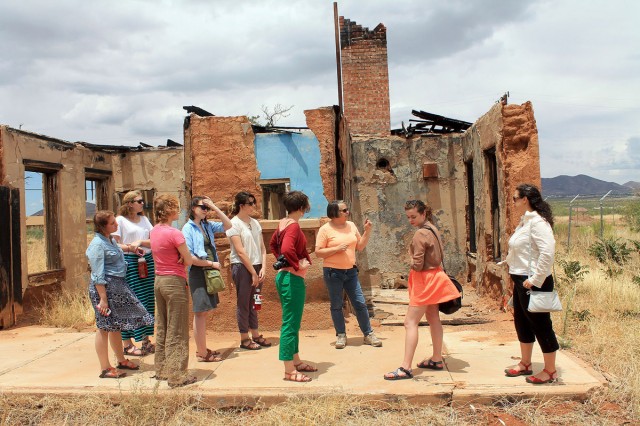- Home
- >
- Preservation Archaeology Blog
- >
- Engaging the Complexities of the Borderlands
Last Friday, some fresh eyes came to Camp Naco, and they helped me to see some things in new ways. Since 2006, I have worked with Becky Orozco, instructor of Anthropology and History at Cochise College, to preserve the historic adobe buildings at Camp Naco. I know the buildings and their stories sufficiently well that sometimes their special impact—the power of place—is overshadowed by the daily necessity to find funds to keep the buildings standing!
The “fresh eyes” belong to a group of eight undergraduates and recent graduates from Hendrix College of Conway, Arkansas, who accompanied their professor, Dr. Anne Goldberg, to Camp Naco on Friday, May 23. Their group blog “Hendrix en la Frontera” describes their mission: “We are spending two weeks traveling along the U.S.–Mexico border, experiencing and exploring the different aspects of education, community, identity, story, language, food, music, art and nature.”
From “why do we create borders?” to “why do so many significant historical events occur at or near borders?”, the buildings of Camp Naco created an environment for exploring complex questions that have no simple answers. The important role of Buffalo Soldiers, African-American military units led by white officers, at Camp Naco also brought issues related to race in both civilian and military contexts into the discussion. Strong winds added a further dimension to this real-world classroom.

The former “back porch” of one of the Officer’s Quarters, shown here, was one classroom where Becky Orozco provided the broader historical context of Camp Naco. For those not familiar with Camp Naco’s recent history, this building was heavily damaged by arson in 2010. The complex array of colors, textures, and charred remnants of this once-vibrant residence lead a careful observer to imagine endless stories about the many people who had called this place home since 1919.
I was surprised that it was a small, intact outbuilding, the pump house for a well, that had the most powerful effect on the students. Artifacts left behind by recent migrants who had found brief shelter in this tiny building provided these young observers with a vital connection to today’s users of this place. I encourage you to read the story in their words and to follow the journey of these students and their professor as they explore the borderland between Douglas/Agua Prieta and San Diego/Tijuana. It’s a chance to see the powerful role of “experiential education” in action. Go to: http://borderlands2014.blogspot.com.

Explore the News
Related to This
-
Project Saving Camp Naco, Arizona
